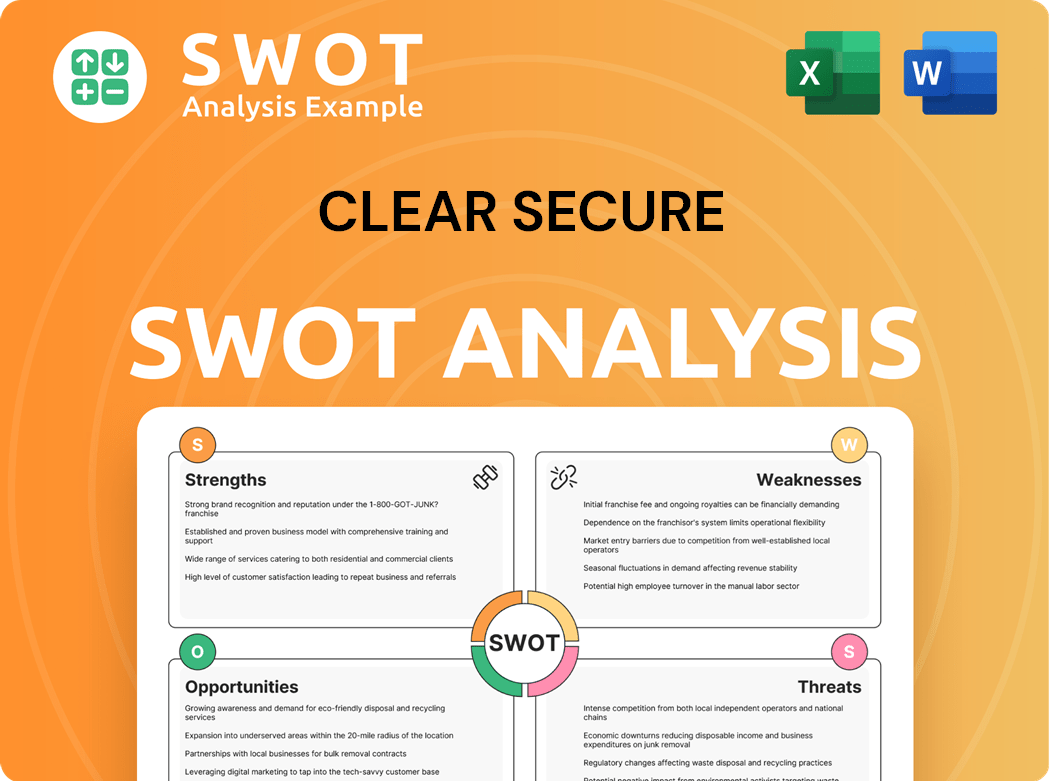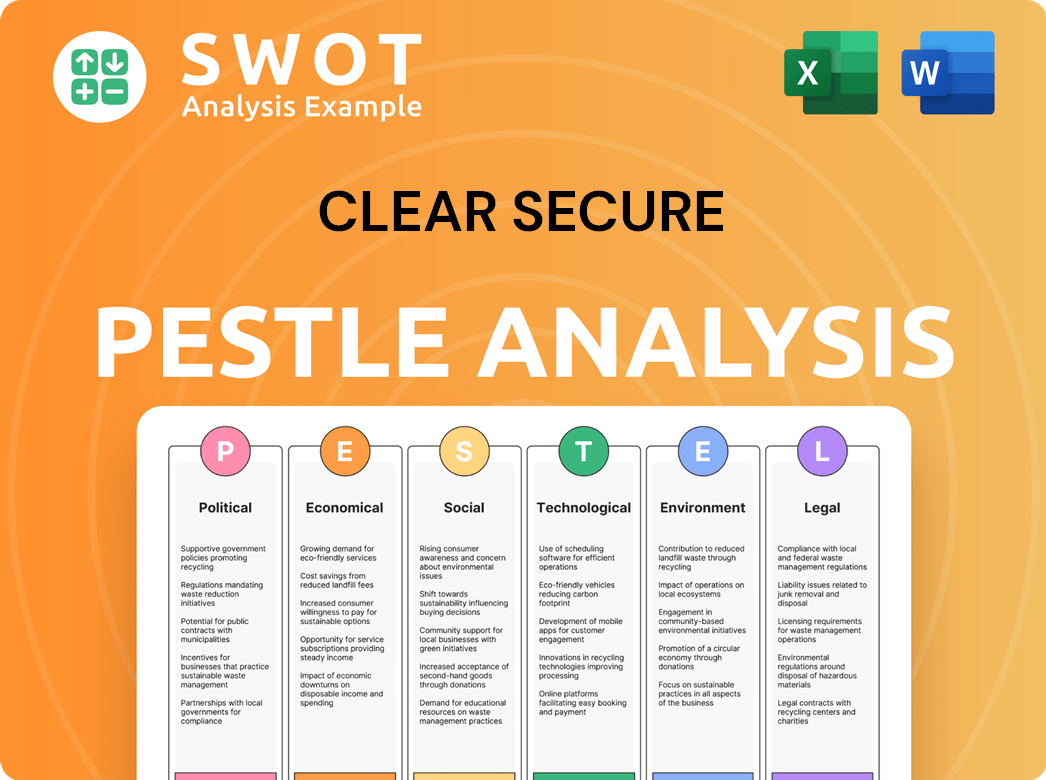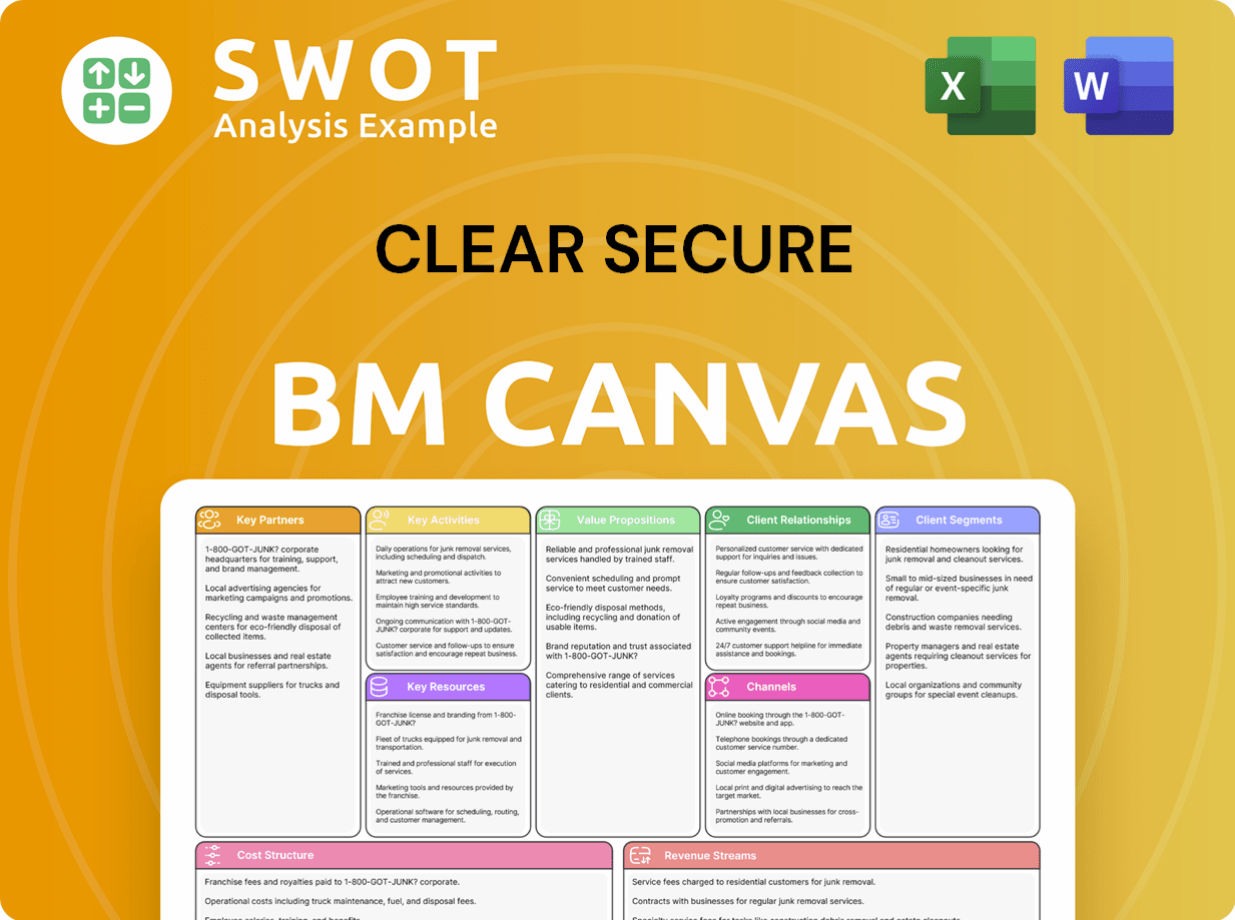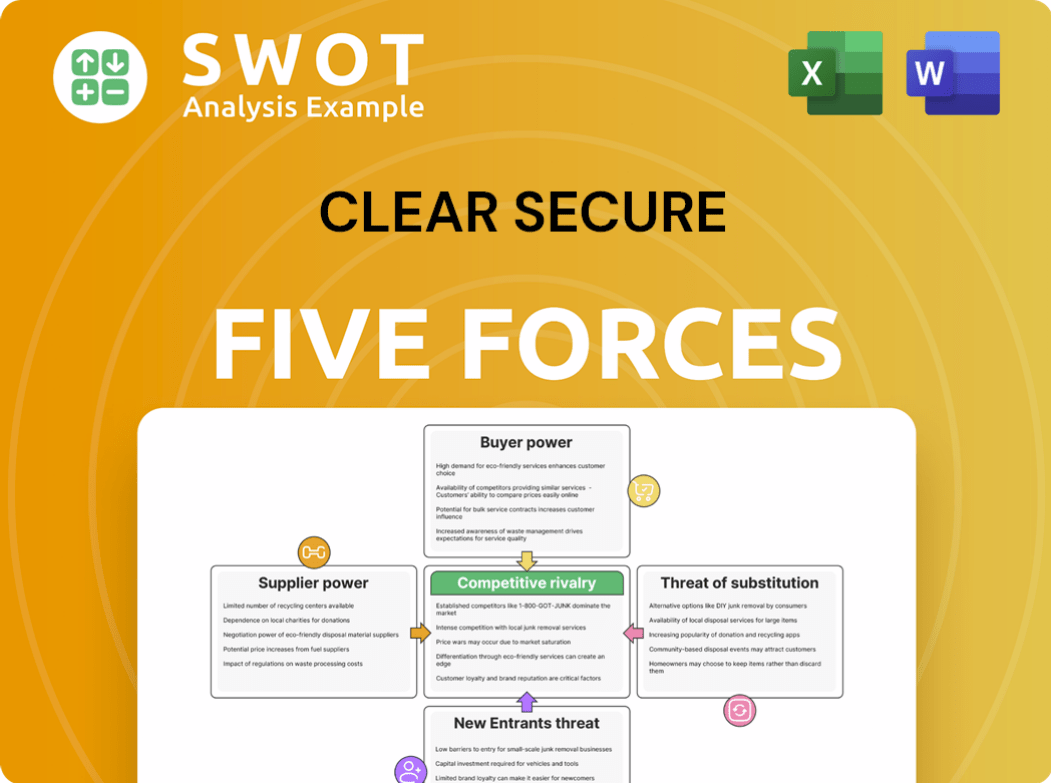Clear Secure Bundle
Who Really Owns CLEAR Secure?
Ever wondered who pulls the strings at CLEAR Secure, the company streamlining airport security with its Clear Secure SWOT Analysis? Understanding the ownership structure of any company is key to grasping its strategic moves and long-term potential. From early investors to public shareholders, the makeup of CLEAR's ownership reveals a fascinating story. This article dives deep, providing a comprehensive look at the forces shaping this leader in biometric security.

The evolution of CLEAR Secure's ownership, from its inception to today, is a crucial aspect of understanding its trajectory. This journey includes early backers, significant investment rounds, and its eventual public listing, each shaping the company's identity verification landscape. Knowing who founded Clear Secure and who holds the most influence is vital for anyone interested in the future of digital identity solutions. We'll explore the influence of the Board of Directors and the dynamics of voting power to reveal how ownership shapes decision-making within the CLEAR Company.
Who Founded Clear Secure?
The company, now known as Clear Secure, was established in 2010. The company was co-founded by Caryn Seidman-Becker and Ken Cornick, who brought a wealth of experience in finance and investment to the venture. Their combined expertise was crucial in shaping the initial direction of the company.
Caryn Seidman-Becker, with her background in finance, and Ken Cornick, with his investment management experience, formed the core of the founding team. While the exact initial equity split isn't publicly detailed, their roles were essential in establishing the company's strategic and financial foundations. Their vision centered around using biometric security for a more seamless identity verification process.
Early backing for the company likely came from angel investors and potentially friends and family. Specific details about these early investors and their stakes aren't widely available in public filings. As the company grew, it secured significant venture capital funding, which would have diluted the founders' initial stakes but provided capital for expansion.
The early ownership structure of the company was primarily shaped by its founders and early investors. The founders' vision of creating a seamless and secure identity experience through biometrics was central to attracting early investment and shaping the company's initial direction and control.
- Founders: Caryn Seidman-Becker and Ken Cornick co-founded the company.
- Early Funding: Initial funding likely came from angel investors and potentially friends and family.
- Vesting Schedules: Agreements such as vesting schedules are common in startups to ensure founder commitment over time.
- Ownership Disputes: There have been no widely reported initial ownership disputes or buyouts among the co-founders that significantly altered the early ownership structure in a public manner.
Clear Secure SWOT Analysis
- Complete SWOT Breakdown
- Fully Customizable
- Editable in Excel & Word
- Professional Formatting
- Investor-Ready Format

How Has Clear Secure’s Ownership Changed Over Time?
The journey of Clear Secure, now known as CLEAR, from a private entity to a publicly traded company marked a pivotal shift in its ownership dynamics. The initial public offering (IPO) on June 30, 2021, was a landmark event. The IPO offered approximately 13.2 million shares at $31.00 per share, resulting in roughly $409.2 million in proceeds. This influx of capital fueled the company's growth and expansion plans.
The shift to public ownership introduced a diverse group of investors, including institutional investors, mutual funds, and individual stakeholders. The IPO diluted the ownership stakes of the founders and early investors, but also provided liquidity and access to capital markets. The company's strategic direction and financial performance are now subject to the scrutiny of public market expectations and the demands of institutional investors.
| Event | Date | Impact on Ownership |
|---|---|---|
| Initial Funding Rounds | Pre-2021 | Venture capital and private equity firms acquired stakes. |
| Initial Public Offering (IPO) | June 30, 2021 | Shift from private to public ownership; founders' and early investors' stakes diluted; institutional investors acquired shares. |
| Post-IPO Performance | 2021-2025 | Changes in institutional holdings based on market performance and investment strategies; founders retain influence. |
As of early 2025, the ownership of CLEAR Secure is largely dominated by institutional investors. These investors, including firms like BlackRock and The Vanguard Group, hold a significant percentage of the outstanding shares, often between 85% to 90%. The founders, Caryn Seidman-Becker and Ken Cornick, remain key individual shareholders, retaining influence through their equity and positions on the Board of Directors. The company's strategy is now heavily influenced by the expectations of these institutional investors, who focus on growth, profitability, and market penetration in the biometric security and digital identity sectors.
CLEAR Secure's ownership structure has evolved significantly since its IPO. The company's ownership is now primarily held by institutional investors, with founders retaining influence.
- Institutional investors hold a substantial majority of shares.
- Founders Caryn Seidman-Becker and Ken Cornick remain key shareholders.
- The IPO provided capital for expansion and growth.
- Changes in ownership influence the company's strategic direction.
Clear Secure PESTLE Analysis
- Covers All 6 PESTLE Categories
- No Research Needed – Save Hours of Work
- Built by Experts, Trusted by Consultants
- Instant Download, Ready to Use
- 100% Editable, Fully Customizable

Who Sits on Clear Secure’s Board?
As of early 2025, the Board of Directors of Clear Secure, also known as Clear Company, is central to the company's governance. The board typically includes representatives from major shareholders, founders, and independent directors. Caryn Seidman-Becker, serving as Chairman and CEO, and Ken Cornick, as President and Chief Financial Officer, both hold board seats. They represent the founding ownership and maintain significant influence over the company's direction.
The board's composition and decisions are regularly detailed in the company's SEC filings, such as proxy statements. These filings provide comprehensive information on director nominees, their affiliations, and the structure of board committees. The presence of independent directors is crucial for ensuring balanced governance and accountability to all shareholders. This structure helps maintain transparency and protects the interests of a diverse shareholder base.
| Board Member | Title | Key Role |
|---|---|---|
| Caryn Seidman-Becker | Chairman and CEO | Oversees overall strategy and operations |
| Ken Cornick | President and CFO | Manages financial aspects and strategic initiatives |
| Independent Directors | Various | Provide oversight and ensure balanced governance |
The voting structure for Clear Secure's common stock generally operates on a one-share-one-vote basis, which is common for publicly traded companies. Founders often retain a degree of control through their equity and board positions, even after an IPO. There have been no widely publicized proxy battles or significant governance controversies that have dramatically reshaped decision-making within Clear Secure in recent years, indicating a stable governance environment.
The board of directors plays a key role in overseeing Clear Secure. The board includes founders and independent directors. The voting structure is typically one-share-one-vote.
- Founders maintain influence through board positions and equity.
- Independent directors ensure balanced governance.
- SEC filings provide detailed information on board decisions.
- Clear Secure focuses on biometric security and digital identity.
Clear Secure Business Model Canvas
- Complete 9-Block Business Model Canvas
- Effortlessly Communicate Your Business Strategy
- Investor-Ready BMC Format
- 100% Editable and Customizable
- Clear and Structured Layout

What Recent Changes Have Shaped Clear Secure’s Ownership Landscape?
Over the past three to five years (2022-2025), the ownership structure of Clear Secure, also known as Clear Company, has seen steady changes. These changes are largely influenced by market conditions and strategic decisions. Since its initial public offering in 2021, the company hasn't engaged in major share buybacks or secondary offerings that would significantly alter ownership percentages. The founders, Caryn Seidman-Becker and Ken Cornick, have remained in key leadership roles, maintaining their influence.
Industry trends, such as increased institutional ownership and the growth of passive investing, are visible in Clear Secure's shareholder base. This can lead to more stability but potentially less active engagement from a fragmented institutional ownership. The company is focused on strategic growth within its current public ownership framework. For more detailed information about the target market, see Target Market of Clear Secure.
| Ownership Category | Approximate Percentage (2024) | Notes |
|---|---|---|
| Institutional Investors | 65-70% | Includes mutual funds, hedge funds, and other institutional holders. |
| Individual Investors | 20-25% | Retail investors holding shares directly. |
| Insiders (Founders & Executives) | 5-10% | Includes Caryn Seidman-Becker, Ken Cornick, and other key executives. |
The company's focus remains on strategic growth within its current public ownership framework. The company has not made public statements about immediate plans for privatization or further public listings beyond its current NYSE status.
Caryn Seidman-Becker and Ken Cornick have maintained key executive and board roles. This leadership continuity provides stability and strategic direction. Their continued involvement ensures a consistent vision for the company's future.
Institutional investors hold a significant portion of Clear Secure's shares. This trend reflects broader market dynamics. Increased institutional ownership can bring both stability and potential challenges in terms of shareholder engagement.
Clear Secure is focused on strategic growth within its existing public framework. This approach suggests a commitment to expanding its services. The company aims to increase its market presence through organic growth and partnerships.
Market dynamics and strategic initiatives drive changes in ownership. These factors include shifts in investor portfolios and the overall economic climate. Understanding these dynamics is crucial for evaluating Clear Secure's future.
Clear Secure Porter's Five Forces Analysis
- Covers All 5 Competitive Forces in Detail
- Structured for Consultants, Students, and Founders
- 100% Editable in Microsoft Word & Excel
- Instant Digital Download – Use Immediately
- Compatible with Mac & PC – Fully Unlocked

Related Blogs
- What are Mission Vision & Core Values of Clear Secure Company?
- What is Competitive Landscape of Clear Secure Company?
- What is Growth Strategy and Future Prospects of Clear Secure Company?
- How Does Clear Secure Company Work?
- What is Sales and Marketing Strategy of Clear Secure Company?
- What is Brief History of Clear Secure Company?
- What is Customer Demographics and Target Market of Clear Secure Company?
Disclaimer
All information, articles, and product details provided on this website are for general informational and educational purposes only. We do not claim any ownership over, nor do we intend to infringe upon, any trademarks, copyrights, logos, brand names, or other intellectual property mentioned or depicted on this site. Such intellectual property remains the property of its respective owners, and any references here are made solely for identification or informational purposes, without implying any affiliation, endorsement, or partnership.
We make no representations or warranties, express or implied, regarding the accuracy, completeness, or suitability of any content or products presented. Nothing on this website should be construed as legal, tax, investment, financial, medical, or other professional advice. In addition, no part of this site—including articles or product references—constitutes a solicitation, recommendation, endorsement, advertisement, or offer to buy or sell any securities, franchises, or other financial instruments, particularly in jurisdictions where such activity would be unlawful.
All content is of a general nature and may not address the specific circumstances of any individual or entity. It is not a substitute for professional advice or services. Any actions you take based on the information provided here are strictly at your own risk. You accept full responsibility for any decisions or outcomes arising from your use of this website and agree to release us from any liability in connection with your use of, or reliance upon, the content or products found herein.